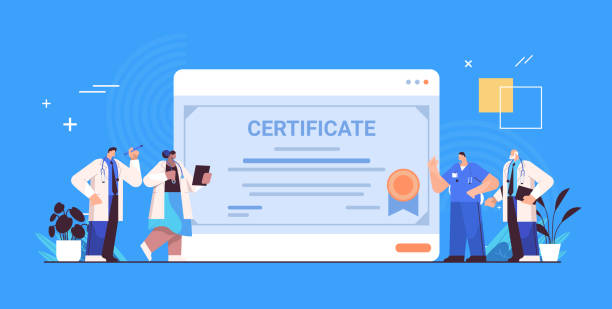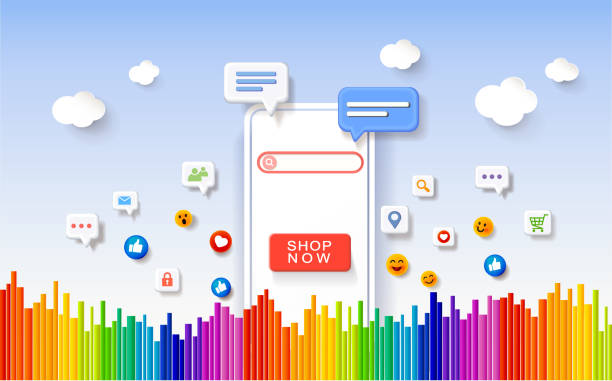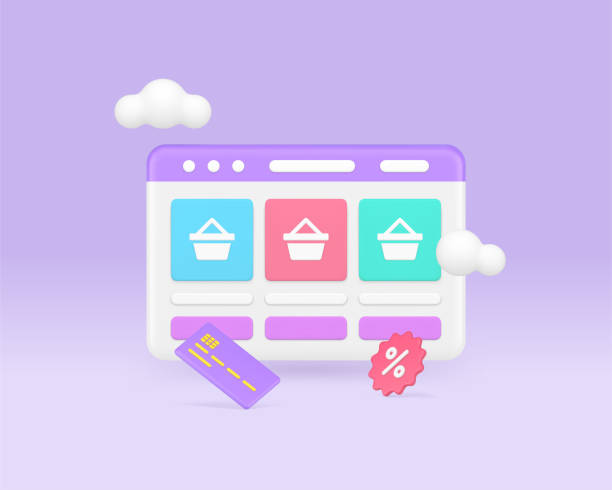Introduction to User-Friendly Website Design and Its Importance

In today’s digital age, having a website is not merely about online presence; rather, the key to #online_success and attracting loyal customers lies in providing an exceptional #user_experience.
This is where the concept of user-friendly website design shows its importance.
A user-friendly website not only has an attractive appearance but is also built in such a way that users can easily #navigate, find the information they need, and achieve their goals.
This approach, beyond visual aesthetics, focuses on how visitors interact with your site.
The main goal of user-friendly website design is to reduce bounce rate, increase time spent on the site, and ultimately, convert visitors into customers or active users.
When a website is designed with users’ needs and behaviors in mind, their positive experience increases, and this directly impacts the credibility and success of the business.
Websites that adhere to the principles of User Experience (UX) design not only attract more visitors but also have a high ability to retain them and convert them into loyal customers.
Therefore, investing in user-friendly website design is an investment in the future of your business.
It is not just an option, but a necessity for any modern business seeking progress and competition in the digital market.
Are you tired of your company’s website not being seen as it should be, and losing potential customers? Solve this problem forever with professional and effective website design by Rasawp!
✅ Increase brand credibility and earn customer trust
✅ Attract targeted sales leads
⚡ Contact us now for a free consultation!
Basic Principles of User Experience (UX) Design for Websites

To achieve a user-friendly website design, understanding and applying the basic principles of User Experience (UX) is essential.
UX encompasses a set of factors that influence how users feel when interacting with your website.
The first principle is Usability; can users easily perform their tasks on the site? Is the site navigation clear and logical? This includes designing clear menus, clear Calls-to-Action (CTAs), and simple forms.
The second principle is Accessibility.
A website should be usable for all users, including those with special needs or disabilities.
This means paying attention to color contrast, using alternative text for images, and keyboard navigability.
WCAG standards are a good guide in this regard.
The next principle is Findability; users should be able to quickly find the information or products they are looking for.
This is achieved through strong search, logical content categorization, and appropriate internal linking.
Credibility is also of high importance.
Your website should appear trustworthy; this includes displaying security badges, customer reviews, transparent contact information, and professional design.
Finally, Desirability refers to the overall appeal of the website; do users enjoy their experience and want to return? This includes visual aesthetics, smooth interactions, and responsiveness of the website.
By adhering to these principles, you can create a strong user experience that not only attracts users but also encourages them to stay on your site for longer and achieve their goals.
These principles are the backbone of any successful design.
Key Elements in Creating a Customer-Centric Website Design

To create a customer-centric website design that truly optimizes user experience, several key elements must be carefully considered.
The first and most important element is intuitive and simple navigation.
Users should be able to move between pages without any confusion.
Clear menus, appropriate internal links, and a logical hierarchical structure are the backbone of strong navigation.
Second, Responsive Design is crucial.
Given the increasing use of mobile devices, your website must display well and maintain its functionality across various screen sizes (mobile, tablet, desktop).
The third element is content readability. Using appropriate fonts, readable font sizes, good color contrast between text and background, and proper paragraphing all contribute to better readability.
Fourth, there should be clear and prominent Calls-to-Action (CTAs).
These buttons or links should encourage users to perform a specific action (such as “Shop Now”, “Sign Up”, “Read More”) and be easily identifiable.
Fifth, effective use of Whitespace helps improve visual clarity and reduce clutter, allowing users to focus on important elements.
Finally, page loading speed significantly impacts user experience.
Websites that load slowly lose users.
Optimizing images, compressing code, and using strong hosting are among the solutions to increase speed.
Paying attention to these elements together ensures that your website not only has an attractive appearance but also provides a smooth and efficient user experience.
Key Elements of Customer-Centric Website Design
| Element | Importance | Brief Description |
|---|---|---|
| Intuitive Navigation | Increases ease of use | Clear menus and logical structure |
| Responsive Design | Accessibility across different devices | Correct display on mobile, tablet, and desktop |
| Content Readability | Increases engagement and comprehension | Appropriate font, size, contrast |
| Calls-to-Action (CTA) | Guides users to business goals | Clear buttons and links for important actions |
| Loading Speed | Retains users and improves SEO | Image and code optimization |
Loading Speed and Technical Optimization for an Excellent User Experience

In today’s world, where speed is paramount, website loading speed is not only a convenience factor for users but also a critical factor for SEO and, consequently, an excellent user experience.
Studies have shown that even a one-second delay in page loading can lead to a significant decrease in conversion rates and an increase in bounce rates.
Users who encounter slow websites quickly abandon them and turn to your competitors.
This not only eliminates sales opportunities but also damages your brand’s reputation.
For user-friendly website design, technical optimization of the website is essential.
One of the most important actions is image compression and optimization.
High-volume images can severely reduce loading speed.
Using appropriate formats (such as WebP) and compression tools significantly reduces their size without a noticeable loss in quality.
In addition to images, optimizing code (CSS, JavaScript, HTML) is also important.
Removing unnecessary code, minification, and concatenation of files can reduce the volume of requests and increase processing speed.
Using Lazy Loading techniques for images and videos also helps improve initial loading speed.
Choosing a strong and reliable web hosting also has a significant impact.
Hosting with high-speed servers and sufficient bandwidth ensures that your website can handle high traffic effectively.
Using a Content Delivery Network (CDN) is also an effective solution for delivering content faster to users worldwide, as it provides content from the server closest to the user.
In summary, any effort to increase website speed is a crucial step towards creating a user-friendly and successful website.
Do you have an e-commerce site, but your sales are not as you expect? Rasawp solves your problem forever with professional e-commerce website designs!
✅ Significant increase in conversion rates and sales
✅ Exceptional user experience for your customers
⚡ Click now for a free consultation with Rasawp!
The Role of Content in User-Friendly Website Design

Content is the heart of every website and plays an indispensable role in user-friendly website design.
Even the best graphic design will not be able to attract and retain users without high-quality and relevant content.
Your content should not only be informative and valuable but also presented in a way that is easily understandable and digestible.
This includes using simple and fluent language, avoiding complex technical jargon (unless necessary and for a specific audience), and logically organizing information.
A strong content strategy should begin with a thorough understanding of the target audience.
What questions do they have? What problems do they want to solve? By addressing these needs through your content, you show users that your website is a reliable and useful resource.
Using engaging headlines, clear subheadings, and short paragraphs helps with content scannability; a feature that is very important for web users who often quickly look for information.
In addition to text, visual content such as high-quality images, infographics, and videos also plays a significant role in enhancing user experience.
These elements can explain complex concepts simply and increase the visual appeal of the site.
Videos are particularly effective for explanatory or entertaining content.
Ensure that images are relevant and high-quality, and that videos are easily playable.
Finally, content must be up-to-date.
Outdated or inaccurate content can erode user trust.
By regularly updating content, you not only provide accurate information to users but also show search engines that your website is active and relevant.
This comprehensive approach to content is an integral part of every successful user-friendly website design.
Visual Appeal and User Interface (UI)

Alongside functional aspects, visual appeal and User Interface (UI) play a vital role in creating a user-friendly website design.
UI is what users see and interact with – buttons, forms, colors, fonts, and the overall page layout.
A beautiful and intuitive user interface can transform a good user experience into an excellent one.
Colors can evoke specific emotions and give your brand an identity.
Intelligent use of a color palette, appropriate contrast for readability, and consistency with brand visual identity are fundamental principles.
Choosing appropriate typography is also very important.
Fonts should be legible and convey your desired emotions and tone.
Correct sizing of fonts for headings, subheadings, and body text helps organize content visually and increases scannability.
Interactive elements such as buttons, forms, and dropdown menus should be designed to be not only aesthetically pleasing but also clear, clickable, and provide appropriate visual feedback.
This assures users that their actions are being registered.
Another key aspect of UI is design consistency. Consistent use of design patterns, colors, fonts, and icons throughout the website helps users become familiar with the environment and have a smoother user experience.
Inconsistency can lead to confusion and frustration.
Animations and micro-interactions can also add to visual appeal and make the user experience more enjoyable, provided they are used in moderation and with the aim of improving the experience, not causing distraction or slowness.
In summary, a well-crafted UI not only makes your website beautiful but also makes interacting with it enjoyable.
Continuous Testing and Optimization for an Excellent User Experience

Even after an initial flawless user-friendly website design, the work is not yet complete.
To achieve and maintain an excellent user experience, continuous testing and optimization are essential.
User behavior and expectations are constantly changing, and your website must adapt to these changes.
A/B testing is one of the most powerful tools in this area.
Using this method, you can display two different versions of a page or a specific element (such as a call-to-action button, title, or layout) to different groups of users and observe which version performs better.
This allows you to make data-driven decisions and eliminate guesswork.
User Testing is also an excellent method for receiving direct feedback from real users.
By observing users while they interact with the website and asking questions, you can discover hidden weaknesses in the design or user flow that may not be visible through analytical data alone.
These tests can include guided tests, card sorting, or tree tests.
Using Web Analytics tools like Google Analytics provides crucial information for tracking user behavior, bounce rates, navigation paths, and conversion rates.
This data can identify weaknesses in the user journey and show you where users encounter problems or leave the site.
For example, if the bounce rate on a specific page is high, it may indicate a need to review the content or design of that page.
Ultimately, continuous optimization is an iterative and ongoing process that helps you constantly improve your website’s user experience and keep it engaging and efficient for your audience.
Methods for Testing and Optimizing User Experience
| Method | Main Goal | Example Tool/Technique |
|---|---|---|
| A/B Testing | Comparing two versions to find the best performance | Google Optimize, Optimizely |
| User Testing | Receiving direct feedback from real users | UserTesting.com, User testing sessions |
| Web Analytics | Tracking user behavior and patterns | Google Analytics, Hotjar (Heatmaps) |
| Heatmaps and Session Recordings | Visualizing user interactions | Hotjar, FullStory |
| Surveys and Feedback | Direct collection of opinions and suggestions | SurveyMonkey, In-site survey tools |
Security and Trust in Web Design

Have you ever wondered why some websites make you feel more secure? Or why you enter your personal information into them without worry? The answer lies in their approach to security and trust in web design.
In today’s era of increasing cyber threats, creating a secure and trustworthy online environment for users is an integral part of user-friendly website design.
Users are increasingly aware of security risks, and a website that ignores these concerns will quickly lose its credibility.
The first step to building trust is using an SSL/TLS certificate, which encrypts the connection between the user’s browser and the website server.
The HTTPS indicator in the browser’s address bar assures users that their connection is secure.
Also, displaying trust and security badges from reputable SSL certificate authorities or well-known security companies can help increase trust.
Transparency in privacy and data is also crucial. Having a clear and accessible privacy policy that explains to users how their information is collected, used, and protected demonstrates your respect for user rights.
For websites with financial transactions, ensuring secure payment processing through reputable payment gateways and encryption of credit card information is vital.
Furthermore, a user-friendly website should provide clear contact information and easy access to customer support.
Phone numbers, email addresses, and even online chat can assure users that they can get help if a problem arises.
Finally, regular software and plugin updates to address security vulnerabilities and protect against cyber-attacks are a crucial part of the commitment to security.
A website that is secure and trustworthy not only protects user information but also builds credibility and loyalty for your brand.
Does your current corporate website not reflect your brand’s credibility and strength as it should? Rasawp solves this challenge for you with professional corporate website design.
✅ Increase visitor credibility and trust
✅ Attract more targeted customers
⚡ Click for a free consultation!
The Future of User-Friendly Website Design: AI and Personalization

The future of user-friendly website design is heavily intertwined with advancements in Artificial Intelligence (AI) and the concept of personalization.
It is no longer enough for a website to be merely functional; users expect experiences that are specifically tailored to their needs and preferences.
AI plays a key role in this area and can revolutionize the way we interact with websites.
One of the most prominent applications of AI in web design is personalization of content and user experience.
By analyzing user data such as search history, previous purchases, location, and even emotional states (through past interactions), AI can tailor relevant content, personalized product suggestions, and even page layouts to be most appealing to each user.
This approach means providing a unique experience for each visitor, which significantly increases conversion rates and engagement.
AI-powered chatbots and voice assistants are also becoming an integral part of user-friendly websites.
These tools can help users find information, answer frequently asked questions, and even complete transactions instantly, without the need for human intervention.
This not only improves customer support but also makes the user experience faster and more efficient.
Furthermore, AI can play a role in automated website optimization.
AI systems can identify user behavior patterns and automatically make changes to design or content to achieve the best performance.
This includes optimizing calls-to-action, testing different UI layouts, and even anticipating user needs before they are aware of them themselves.
The future of user-friendly website design will undoubtedly be smarter and more personalized.
Summary and Next Steps for Successful Website Design

Throughout this article, we explored various dimensions of user-friendly website design, from its importance in online success to technical and visual details and its future with AI.
Now it’s time to put this knowledge into practice.
A user-friendly website is not merely about a beautiful appearance; rather, it is a comprehensive approach that focuses on user needs and expectations to provide an unparalleled and effective experience.
This includes easy navigation, high loading speed, relevant and readable content, responsive design, and most importantly, a focus on trust and security.
The next steps for designing a successful and user-friendly website are:
- Comprehensive Research and Planning: Before any design, thoroughly understand your audience and define the website’s goals.
User research is the cornerstone of any successful design. - Prioritize User Experience (UX): Ensure that every design decision leads to an improved user experience.
From the initial planning stages to final implementation, the user must be at the center of attention. - Focus on Quality Content: Your content should be valuable, relevant, and easily understandable.
Good content alone can be your differentiator. - Technical Optimization and Speed: Your website must load quickly and function well on all devices.
Speed and responsiveness are no longer options, but indispensable necessities. - Continuous Testing and Optimization: Your website is a living project.
Regularly test it, gather feedback, and improve it based on data. - Security and Transparency: Gain user trust by providing a secure environment and transparent privacy policies.
Remember that user-friendly website design is an ongoing process, not a final destination.
By following these principles and steps, you can build a website that not only meets your business goals but also keeps users happy and loyal.
This investment will ultimately yield significant returns.
Frequently Asked Questions
And other services of Rasawp Advertising Agency in the field of advertising
Smart Conversion Rate Optimization: A new service for improving SEO ranking through marketing automation.
Smart Direct Marketing: Revolutionize online growth with marketing automation.
Smart Google Ads: A new service for increasing website traffic through user experience customization.
Smart Google Ads: Professional optimization for campaign management using SEO-driven content strategy.
Smart Brand Identity: A professional solution for analyzing customer behavior with a focus on precise audience targeting.
And over hundreds of other services in the field of internet advertising, advertising consulting, and organizational solutions
Internet Advertising | Advertising Strategy | Advertorials
Resources
UI and UX Design Principles
The Importance of Website Design
SEO for Beginners
Online Marketing
? Are you ready to transform your business in the digital world? Rasawp Afarin, a leading digital marketing agency, specializes in SEO, online advertising, and responsive website design to help you reach the peak of success and establish a powerful web presence.
📍 Tehran, Mirdamad Street, next to Bank Markazi, Southern Kazeroun Alley, Ramin Alley, No. 6


